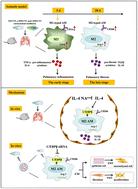当前位置:
X-MOL 学术
›
Environ. Sci.: Nano
›
论文详情
Our official English website, www.x-mol.net, welcomes your
feedback! (Note: you will need to create a separate account there.)
IL-4-activated C/EBPβ is involved in alveolar macrophage polarization towards the M2 phenotype during pulmonary fibrosis induced by single-walled carbon nanotubes
Environmental Science: Nano ( IF 5.8 ) Pub Date : 2022-09-30 , DOI: 10.1039/d2en00581f Xiang Zhang 1 , Jiaojiao Zhu 1 , Shuxin Yang 2 , Zhuomeng Yao 1 , Sujuan Zhao 1 , Yan Wang 3 , Chengfan Zhou 1 , Qixing Zhu 1 , Tong Shen 1
Environmental Science: Nano ( IF 5.8 ) Pub Date : 2022-09-30 , DOI: 10.1039/d2en00581f Xiang Zhang 1 , Jiaojiao Zhu 1 , Shuxin Yang 2 , Zhuomeng Yao 1 , Sujuan Zhao 1 , Yan Wang 3 , Chengfan Zhou 1 , Qixing Zhu 1 , Tong Shen 1
Affiliation

|
Given the rapid development in the field of nanotechnology, the potential toxicity of carbon nanotubes (CNTs) in humans has received much attention in recent years. However, the exact mechanisms are still not clear. The current study aimed to investigate the role of alveolar macrophage (AM) polarization during pulmonary fibrosis induced by CNTs, as well as the underlying molecular mechanism of SWCNT-induced pulmonary fibrosis. In vivo, C57BL/6J mice were intratracheally instilled with single-walled CNTs (SWCNTs), short-type multi-walled CNTs (s-MWCNTs) and long-type multi-walled CNTs (l-MWCNTs). Then, AM polarization and pulmonary inflammation and fibrosis were evaluated on days 3, 7 and 28. The results showed that CNTs promoted AM polarization towards the M1 phenotype and pulmonary inflammation during the early stage, while AMs were polarized towards the M2 phenotype, which was accompanied by pulmonary fibrosis during the late stage. Notably, SWCNTs have the strongest capacity to induce M2-type AM polarization and pulmonary fibrosis among the three types of CNTs. Mechanistically, the interleukin-4 (IL-4) levels in bronchoalveolar lavage fluid were upregulated in SWCNT-exposed mice, and C/EBPβ was the most markedly upregulated gene among 15 polarization-related genes in AMs from SWCNT-exposed mice. Abolishing IL-4 with an IL-4 neutralizing antibody (IL-4 NA) inhibited C/EBPβ upregulation and AM polarization towards the M2 phenotype and ameliorated SWCNT-induced pulmonary fibrosis. In vitro, knockdown of C/EBPβ using C/EBPβ siRNA reduced SWCNT-induced M2 AM polarization and ameliorated epithelial–mesenchymal transition and myofibroblast activation that were two critical stages during the development of fibrosis. In summary, we identified that IL-4-activated C/EBPβ participated in SWCNT-mediated M2 AM polarization and subsequent pulmonary fibrosis. Our findings provide new evidence for understanding the mechanism of CNT-induced pulmonary fibrosis, and IL-4 may be useful as a diagnostic biomarker and therapeutic target for nanoparticle-induced fibrogenesis.
中文翻译:

在单壁碳纳米管诱导的肺纤维化过程中,IL-4 激活的 C/EBPβ 参与了肺泡巨噬细胞向 M2 表型的极化
鉴于纳米技术领域的快速发展,碳纳米管(CNTs)对人体的潜在毒性近年来备受关注。然而,确切的机制仍不清楚。本研究旨在探讨肺泡巨噬细胞(AM)极化在碳纳米管诱导的肺纤维化过程中的作用,以及单壁碳纳米管诱导肺纤维化的潜在分子机制。体内, C57BL/6J 小鼠气管内灌输单壁碳纳米管 (SWCNTs)、短型多壁碳纳米管 (s-MWCNTs) 和长型多壁碳纳米管 (l-MWCNTs)。然后,在第 3、7 和 28 天评估 AM 极化和肺部炎症和纤维化。结果表明,CNT 在早期促进 AM 极化向 M1 表型和肺部炎症,而 AM 极化向 M2 表型,即晚期伴有肺纤维化。值得注意的是,单壁碳纳米管在三种碳纳米管中具有最强的诱导 M2 型 AM 极化和肺纤维化的能力。从机制上讲,在暴露于 SWCNT 的小鼠中,支气管肺泡灌洗液中的白细胞介素 4 (IL-4) 水平上调,在暴露于 SWCNT 的小鼠的 AMs 中,C/EBPβ 是 15 个极化相关基因中最显着上调的基因。用 IL-4 中和抗体 (IL-4 NA) 消除 IL-4 可抑制 C/EBPβ 上调和 AM 向 M2 表型的极化,并改善 SWCNT 诱导的肺纤维化。在体外,使用 C/EBPβ siRNA 敲低 C/EBPβ 可减少 SWCNT 诱导的 M2 AM 极化并改善上皮-间质转化和肌成纤维细胞活化,这是纤维化发展过程中的两个关键阶段。总之,我们发现 IL-4 激活的 C/EBPβ 参与了 SWCNT 介导的 M2 AM 极化和随后的肺纤维化。我们的研究结果为理解 CNT 诱导的肺纤维化机制提供了新的证据,并且 IL-4 可用作纳米颗粒诱导的纤维化的诊断生物标志物和治疗靶标。
更新日期:2022-09-30
中文翻译:

在单壁碳纳米管诱导的肺纤维化过程中,IL-4 激活的 C/EBPβ 参与了肺泡巨噬细胞向 M2 表型的极化
鉴于纳米技术领域的快速发展,碳纳米管(CNTs)对人体的潜在毒性近年来备受关注。然而,确切的机制仍不清楚。本研究旨在探讨肺泡巨噬细胞(AM)极化在碳纳米管诱导的肺纤维化过程中的作用,以及单壁碳纳米管诱导肺纤维化的潜在分子机制。体内, C57BL/6J 小鼠气管内灌输单壁碳纳米管 (SWCNTs)、短型多壁碳纳米管 (s-MWCNTs) 和长型多壁碳纳米管 (l-MWCNTs)。然后,在第 3、7 和 28 天评估 AM 极化和肺部炎症和纤维化。结果表明,CNT 在早期促进 AM 极化向 M1 表型和肺部炎症,而 AM 极化向 M2 表型,即晚期伴有肺纤维化。值得注意的是,单壁碳纳米管在三种碳纳米管中具有最强的诱导 M2 型 AM 极化和肺纤维化的能力。从机制上讲,在暴露于 SWCNT 的小鼠中,支气管肺泡灌洗液中的白细胞介素 4 (IL-4) 水平上调,在暴露于 SWCNT 的小鼠的 AMs 中,C/EBPβ 是 15 个极化相关基因中最显着上调的基因。用 IL-4 中和抗体 (IL-4 NA) 消除 IL-4 可抑制 C/EBPβ 上调和 AM 向 M2 表型的极化,并改善 SWCNT 诱导的肺纤维化。在体外,使用 C/EBPβ siRNA 敲低 C/EBPβ 可减少 SWCNT 诱导的 M2 AM 极化并改善上皮-间质转化和肌成纤维细胞活化,这是纤维化发展过程中的两个关键阶段。总之,我们发现 IL-4 激活的 C/EBPβ 参与了 SWCNT 介导的 M2 AM 极化和随后的肺纤维化。我们的研究结果为理解 CNT 诱导的肺纤维化机制提供了新的证据,并且 IL-4 可用作纳米颗粒诱导的纤维化的诊断生物标志物和治疗靶标。











































 京公网安备 11010802027423号
京公网安备 11010802027423号